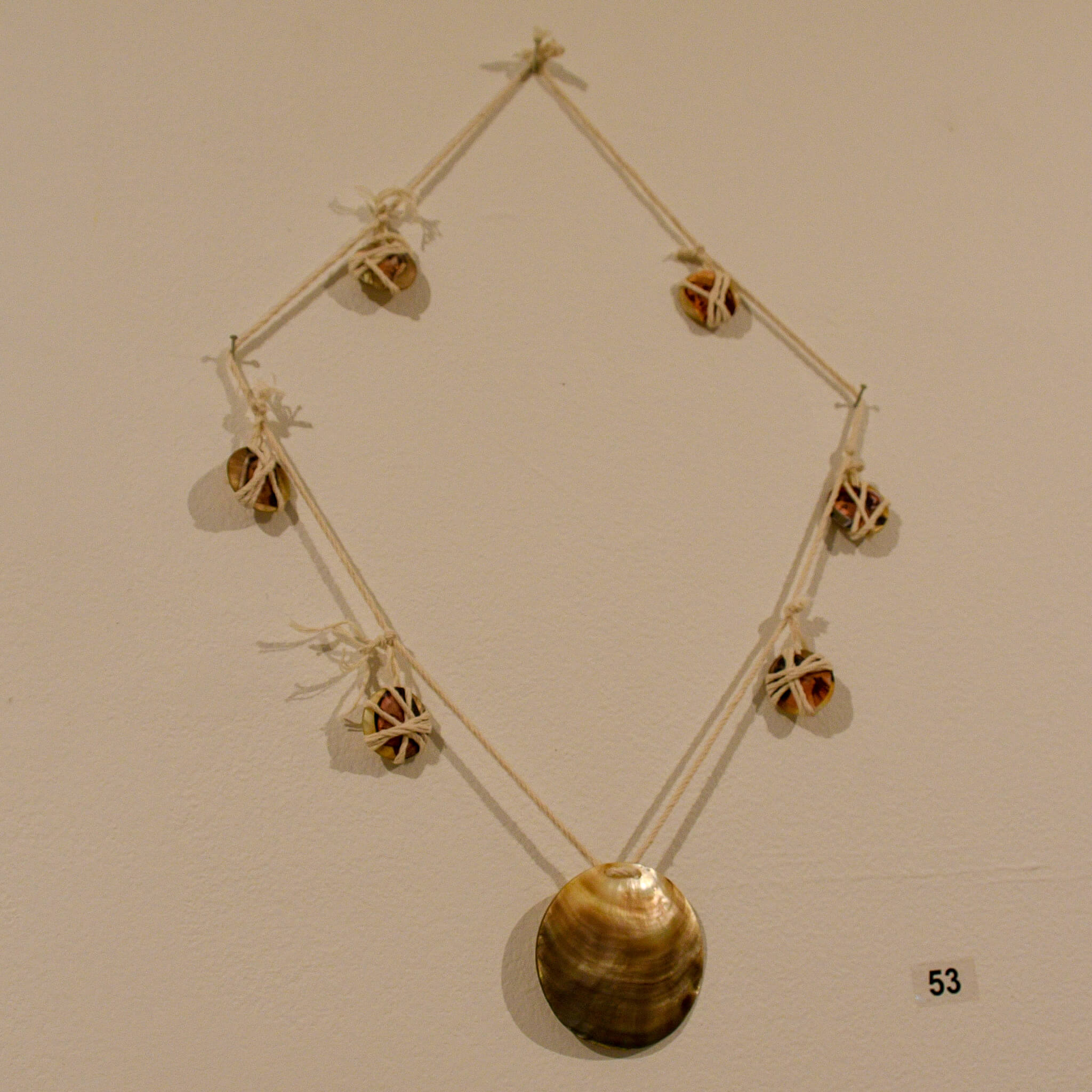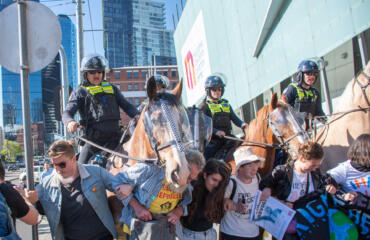The works of three young Aboriginal women – Edwina Green, Indiah Money and Pierra Van Sparkes – showcase the variety of pieces in this year’s Koorie Art Show, and of Aboriginal and Torres Strait Islander art more broadly.
This year, 115 Indigenous artists have submitted 195 entries to the exhibition, which opens today. For the first time the show also features a small collection of works from children and youths.
Kate ten Buuren and Zenzi Clark, the gallery’s assistant curators, have been collecting the works over the past few weeks. The result, says Ten Buuren, a Taungurung woman, is “a huge range of objects and artworks that reflect the breadth of work that Koorie people make.
“We have multimedia work on skateboard decks. There’s paintings on canvas, photographs, wooden sculptures, people that are creating objects like their ancestors made. We’ve got video pieces.”

Edwina Green’s piece, Not A Maireener Shell Necklace, on the wall at the Koorie Art Show
Green is a 19-year-old Pakana woman, and a first-time contributor to the Koorie Art Show, who grew up living between Melbourne and Tasmania’s west coast. She’s crafted a necklace that follows the NAIDOC week theme from July 2018 – “Because of her, we can!”. The week was a celebration of the important contributions Aboriginal and Torres Strait Islander women make to their families, their communities and to the nation
“It’s titled Not A Maireener Shell Necklace. It speaks about the impact of colonisation on me,” Green says.
“I didn’t really grow up with strong ‘blak’ female figures, except for the women who are related to me.”
Shell necklace-making is a cultural tradition for Tasmanian Aboriginal women, but as Green explains, her mum, Ann, didn’t grow up with cultural knowledge, and therefore, couldn’t pass down traditions like this one. Green’s necklace features seven shells – six that depict female religious figures, and one maireener shell, which she deliberately left blank.
“My mum is very proud of being Aboriginal, but didn’t have the resources and energy to learn that cultural knowledge … my grandfather was Aboriginal, and he didn’t teach her … I don’t even know if he knows language, which is due to Aboriginal people not being allowed to be brought up with their own languages,” Green says.

A close-up of one of the religious figures on Edwina Green’s necklace
“I didn’t grow up learning that cultural knowledge that is so needed for me to be who I am … It’s intergenerational, and it’s the story for a lot of Aboriginal people. We just weren’t allowed to know our culture.”
Green says events like the Koorie Art Show are changing that landscape for young Indigenous people. “The great thing about my generation is that we’ve got these resources and exhibitions. We have Indigenous-only collections – when my Mum was born, she didn’t have the same opportunities.”
Indiah Money – a 21-year-old Wiradjuri woman who grew up on Boon Wurrung country – has submitted two paintings for what will be her third Koorie Art Show.
Money loves clay and sculpture work, but facilities are hard to access. She’s a student, renting and also working full-time, so instead, she paints. She’s always been involved in art.
“I’ve been doing art since I was two. I was always encouraged as a kid to be creative,” Money says.
Her first piece, two years ago, was a little pine cone baby. Both her works for this year’s show are a continuation of the same collection of work – about stillbirths and miscarriages – which she originally started when she was 17.
“I think there’s such a lack of conversation surrounding abortions, miscarriages and stillbirths, because of the fear of it making people uncomfortable … it’s such a dirty secret that no one really talks about when it should be this normalised thing, it shouldn’t have to be this big scary thing,” she says.
The first of her paintings this year – At Home – features a pair of babies still in the womb, wearing crowns.

Indiah Money’s second painting, called Staying Still
“So many people interpret it as a massive celebration of life, and to a degree, it is … it’s very much about a miscarriage that’s happened later on,” she says
The crown’s represent the idea of immortality, and the fact that even though the baby has passed away, it will always be special to that mother. Two circles in the top right corner, Money explains, represent “woman” or “feminine” in Wiradjuri symbology. She has the same two circles tattooed on her wrist.
The second – Staying Still – (pictured right) has the fetus looming over two parents.
“Putting the fetus at the forefront represents the importance of that life … it’s in this circle, representing the womb space, a safe space. And then also the two parents, who I envisioned as being two mums … I tried to create that image of that moment the baby passes away. It’s that immediate moment of transition from life to death.”
Like Money, Pierra Van Sparkes is taking part in her third show. She’s submitted two works – a framed photograph and a video.
Van Sparkes, 24, is a Pibbulman woman who grew up surrounded by camera equipment. Her mum, Lisa, and her nan, Jocelyn, were big artistic influences. Her dad, Shane, was a keen photographer.
“I’d just borrow some of his cameras and make videos and stuff like that …. it’s just what came to me with the resources I had around,” she says.
Her framed photograph for this year’s show is called Look Out Below!, and was taken on a whim when she was walking past Footscray Station.
“It was just a passing moment. There’s no subjects in the image. The flowers were, ya know, lifting your spirit and your mood, it’s such a nice time of year once they bloom. The image of the [security] camera overlooking the scene just reminded me, once again … you know, you get a glimmer of what things could’ve been like, and then bam! The colonial project’s right there, always looking out over you,” she explains.
Her video – Because Of Her, We Will! – was first presented for NAIDOC Week in July. Walking along High Street one in Thornbury, Van Sparkes spotted an abandoned shop window with ripped vinyl in red, yellow and black – the colours of the Aboriginal flag – blowing in the wind. She shot the window, and the traffic, and in the foreground of the video, she’s overlaid her own words.
“I’m speaking to my mum, speaking to my little sister, speaking to my nan. Sometimes I feel strength and conviction, sometimes I’m looking for the way. Being in a big city I’m asking them to keep me true to who I am and to my family,” she says.
In 2016, Van Sparkes entered a digital print on canvas, called Blackfulla Bingo, inspired in part by her nan, Jocelyn. Jocelyn often took Van Sparkes and her cousins to bingo when they were growing up. The work features squares with statements and questions Van Sparkes, and the people are around her, have faced in their lifetimes, such as, “If you’re Aboriginal, why are you white?”
“It’s about resilience, and that black humour. My Nan’s motto, of sorts, was ‘if you don’t laugh, you’ll cry’,” she says.
The exhibition opens today, Saturday 8 December, at the Koorie Heritage Trust in Federation Square and will run until February 24, 2019.

One of the walls of the 2018 Koorie Art Show




